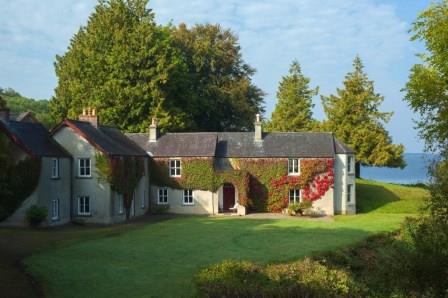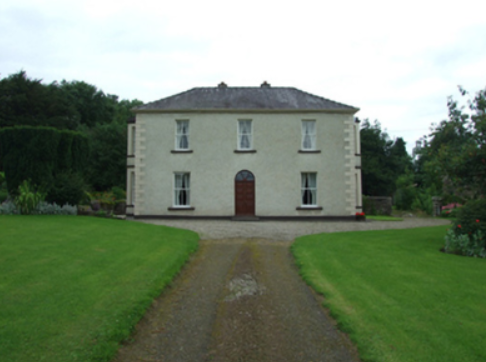Fortland House
Houses within 15km of this house
Displaying 20 houses.
Houses within 15km of Fortland House
Displaying 20 houses.
| House name | Description | |
|---|---|---|
| Glenade | Glenade was built c.1833 as a residence for Cairncross Cullen and is still extant. At the time of Griffith's Valuation it was valued at £30. Since 2005 it has been offered for sale. Glenade House was the residence of Loftus Tottenham during the Famine. The family also owned Cornwall House in Bundoran. In 1906 Thomas Corscadden owned 100 acres of untenanted land and a mansion house valued at £14 in the townland of Gubinea . |

|
| Glenboy | There were two houses at Glenboy townland, one at least of which was part of the Clements estate but appears to have been leased for long periods to the Algeo family. John Marcus Clements, MP for Leitim, is described as "of Glenboy". He was nephew of Robert Clements, 1st Earl of Leitrim. A house at Glenboy was the residence of John Algeo in 1814. Glenboy is described as a seat of the Algeo family by Lewis in 1837 while Hollymount is the residence of the Armstrong family. At the time of Griffith's Valuation, Lewis Algeo was leasing house at Glenboy, valued at £25, to Simon Armstrong while he was also leasing a house from the Clements estate valued at £12. Houses are still extant at these locations. | |
| Skreeny | Skreeny seems to have been built during the 1690s. It is recorded as a seat of the Cullen family by both Taylor and Skinner and Wilson in the 1780s. During the Famine period it was used as a temporary fever hospital. The townland was in the possession of the Earl of Leitrim by the time of Griffith's Valuation where the only buildings recorded area a gate house and offices, valued at £1 10s. Skreeny House is labelled as "in ruins" on the 25-inch Ordnance Survey map of the 1890s. The Irish Tourist Association survey of the 1940s recorded that it was "the ruins of one of the principal gentry seats in the area". | |
| Newtown Manor | A house built after the publication of the First Ordnance Survey map. John James Whyte held this property in fee at the time of Griffith's Valuation, when itwas valued at £12. Slater notes that it was the residence of Captain Edward T. Pottinger in 1894. In 1906 Charles B. Whyte was the owner of the house at Carrickfad valued at £22. It is no longer extant. | |
| Drumahaire Lodge | Dromahaire Lodge was part of the Lane-Fox estate and was usually the home of the agent. During the 19th century these included D. Stewart and Joshua Kell. To the rear site are the ruins of a seventeenth-century fortified house, built by Sir William Villiers and formerly the seat of the O'Rourke family. |

|
| Larkfield | In 1786 Wilson refers to Larkfield as the seat of Mr. Donnell. Larkfield is described as a very plain house but nevertheless its construction is alleged to have caused financial embarrassment for the O'Donnell estate. It was valued at £15 at the time of Griffith's Valuation when it was occupied by John O'Donnell. After the purchase of the estate by the Land Commission in the 1930s the house was demolished and another house has been constructed on the site. | |
| Belhavel | Belhavel was the home of Hugh Lyons Montgomery, built during the Famine. The family took up residence there in 1850. Slater refres to it as the seat of Hugh Lyons Montgomery in 1894. The Irish Tourist Association survey in the 1940s records that "every stone was taken away to build houses throughout the district". An earlier castle also in Belhavel is reputed to have been built by the first Montgomery to settle in the area in the seventeenth century. | |
| Glenfarne Hall | Glenfarne Hall, overlooking Lough MacNean, was built around 1820 for Charles Henry Tottenham. In 1906 it was owned by Col. J.G. Adamson and was valued at £50. It was subsequently a holiday home of Edward Harland of Harland & Wolf shipyards in Belfast. The 1943 Irish Tourist Association survey recorded that only the gutted ruins of the house remained.The area has been extensively afforested since then and is now part of a forest park owned by Coillte. |

|
| Hollymount (Drumahaire) | Hollymount House is said to have been built around 1730. It was leased to Simon Armstrong by Lewis Algeo. Home of Thomas Corscadden in 1910. It is now a ruin but the outbuildings survive. |

|
| Sriff Cottage | Sriff Cottage was associated with the Palmer family and possibily originally used as a hunting lodge. At the time of Griffith's Valuation, it was being leased from the Lane Fox estate by Henry Palmer and was valued at £4. This house is still extant and in 2015 was offered for sale. |

|
| Rockwood | At the time of Griffith's Valuation Hester Cullen was leasing a house valued at £10 at Deerpark, barony of Rosclogher to Thomas Davis, MD. A house still exists on the site of the original Rockwood House. | |
| Fortland Cottage | Fortland Cottage was built on part of the Cullen estate in the 18th and was the home of Jane Cullen and her husband G. Gledstanes in the mid-nineteenth century. |

|
| Brookfield House | Arthur Loftus Tottenham was leasing a house valued at £14 to James Tate here in 1856. |

|
| Drumlease Glebe | Rev. Wilby Wynne was occupying Drumlease Glebe, barony of Dromahaire, at the time of Griffith's Valuation when it was valued at £20. McParlan includes John Carter and brothers of Drumlease on a list of "resident gentlemen of property" in 1802. |

|
| Glasdrumman More | William Palmer was the owner of a property valued over £7 at Glassdrumman More, barony of Rosclogher at the time of Griffith's Valuation. The house is still extant and occupied. |

|
| Tawnahoney | At the time of Griffith's Valuation, Patrick Buchan, agent to the Creevlea Iron Works, was leasing buildings valued at £17 at Tawnahoney, barony of Dromahaire, from John Johnston. This property does not appear to be extant at the time of the 25-inch Ordnance Survey map in the 1890s. In 1786 Wilson had noted a property in the nearby townland of Gortermone as a seat of Mr. Johnston. It is not shown on the Ordnance Survey maps. | |
| Dunmuckrum | At the time of Griffiths Valuation, David Stewart, senior, was leasing a property valued at £10 from the Conolly estate. | |
| Corrard | Located on the Parker estate the National Inventory of Architectural Heritage states that there have been three houses built on this site, the present house dates from the 1920s while the original was a small structure marked on the first edition six inch Ordnance Survey map (publ. 1837). John Carson occupied Corrard at the time of Griffith’s Valuation. The buildings were valued at £10. The Carson family were still resident at the beginning of the 20th century. |

|
| Upper Thornhill House | Burke’s Landed Gentry of Ireland (1958) records the Nixon family of Thornhill in the 18th century. Thornhill was located on the Parker estate. By the mid-19th century William Nixon was the occupier. The house was valued at £6. The Nixon family continue to live here in the early 20th century. This house is no longer occupied. |

|
| Tuam House | Located on the Saunders estate, outside the village of Blacklion, the present house replaced a former building marked on the first edition six inch Ordnance Survey map (publ. 1837). The Hassards lived at Tuam in the 18th century. Griffith’s Valuation records Hugh Bracken as the occupier, when the building was valued at £5. Hugh married Elizabeth Copeland and died in 1861. In 1876, James Bracken of Tuam House owned 51 acres county Cavan and 1,268 acres in county Fermanagh. Members of the Bracken family were resident at Tuam throughout the 20th century. The name of this house is sometimes spelt Toam. It is well maintained and occupied. |

|

